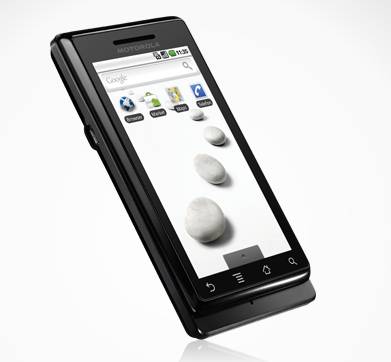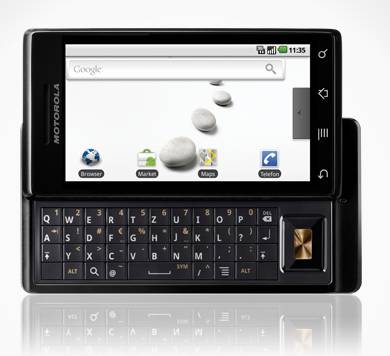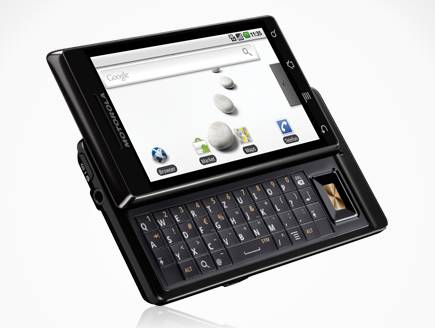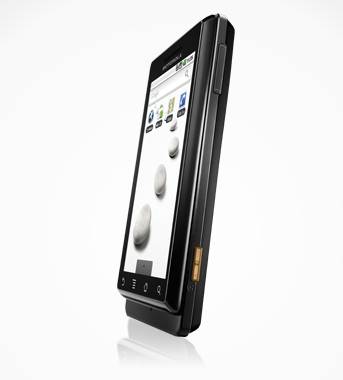 We have been messing around with the Motorola Milestone for more than a fortnight now (almost since its release in India) and at the cost of shocking several iPhone fans, we must admit that the device is the first to really give what they call the Godphone, some very serious competition. And we say this after having tried out the likes of the Nexus One, the HTC HD2, the Acer Liquid and the Sony Ericsson Xperia X1o. Small wonder that the folks at Verizon used the Droid version of the device to take on the iPhone in the US.
We have been messing around with the Motorola Milestone for more than a fortnight now (almost since its release in India) and at the cost of shocking several iPhone fans, we must admit that the device is the first to really give what they call the Godphone, some very serious competition. And we say this after having tried out the likes of the Nexus One, the HTC HD2, the Acer Liquid and the Sony Ericsson Xperia X1o. Small wonder that the folks at Verizon used the Droid version of the device to take on the iPhone in the US.
What makes the Milestone really tick is the fact that it does the basics almost as well as the iPhone – the interface is simple, the device is fast, there are apps aplenty – and then throws in a few shimmies of its own, such as a decent 5MP camera, good video quality, a larger touchscreen with multi-touch, and critically, a very, very handy slideout QWERTY keypad. And just like the iPhone, it does not do too badly in the looks department either, with its mix of plastic and metal (we love the gold touches on the camera button and the middle of the D-pad) and a relatively svelte figure that is just 13.7mm thick, although at 165 grammes, this ain’t exactly featherweight.
Looked at in pure tech spec terms, the Milestone seems impressive, rather than overwhelming. It packs in a ARM Cortex A8 600 MHz processor, 3.7 inch TFT capacitive screen with 16 million colours and a resolution of 480×854, with a 5.0 megapixel camera that also does video at a very creditable 720×480 pixels at 24fps, supports upto 32GB storage (you get an 8GB expansion card free with the device) and every connectivity option from GPS to Wi-Fi. Not bad, but not really stand out if one considers the 1GHz processors, 4 inch displays and 8 megapixel cameras that some models are flaunting.

And yet, the Milestone outperforms them all and brilliantly at that. Unlike HTC and Sony Ericsson, Moto has resisted the temptation to place a skin over the Milestone’s homescreen (the Droid in the US comes with a Blur interface that delivers all sorts of social networking information on the homescreen) and what it loses in terms of being a spectacle, it gains in terms of speed and simplicity. One of the great things about the iPhone was that once it started, all you needed to do was just touch icons to get going. Well, the Milestone pretty much does the same and it is a tribute to its developers that it does so at a very brisk rate. It was definitely faster than any of the Android phones we have used so far – perhaps the fact that it is one of the few devices that runs on the latest version of Android (2.1) helps. There were hardly any lags even when we had slapped more than fifty apps on the device, using up a good deal of its 133 MB onboard storage. Incidentally, that storage capacity is one of our quibbles about the device, given the fact that Android apps tend to get installed mainly on the device memory and not on expansion cards. Google is supposed to be working on it and hopefully, one of the future updates will sort it out.

The Android edge that the Milestone enjoys becomes most evident when one is multitasking. You can literally run half a dozen apps and keep getting notifications from another six, without the device stuttering, and while it does come with a very nice onscreen QWERTY keypad, having the slideout physical keypad is a blessed advantage for text freaks like us. The keyboard might seem a tad uncomfortable initially but once one gets the hang of it, it performs without a hitch – we were composing blog posts and longish mails and tweets in next to no time. The camera turned in decent results in the daylight in both still and video modes, although it was pretty ordinary indoors. Best of all, the battery life, once we had conditioned the battery by charging it for eight hours on the trot the first three times we charged it, was good enough to see us through the day with lots of services running.

It looks good, it does almost everything that the iPhone does and throws in a more megapixelled camera (with a dedicated hardware camera key), a larger screen and a physical keypad, and has about the same battery life as well as the capacity to store as much information. All of which we think, is more than enough to make the Motorola Milestone the first real contender to the iPhone’s throne and by far the best QWERTY keypad- touchscreen smartphone we have ever seen. If the iPhone still holds sway, it is because of its brilliantly simple interface which can at times make even Android look a tad ordinary, the massive speed boost that it has got of late, and of course, that awesome app library that no one seems to be able to match. However, no phone has quite challenged the iPhone’s supremacy like this one has, or has really, really shown what Android is capable of doing.
It does not quite slay it, but the Milestone does make the Godphone look oddly mortal at times, and surely that counts for something. Welcome back, Moto.
